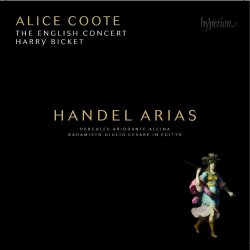
|
George Frideric HANDEL (1685-1759)
Arias
Radamisto
Quando mai, spietata sorte [3:08]
Alcina
Mi lusinga il dolce affetto [7:45]
Verdi prati [4:50]
Stà nell’Ircana [6:00]
Hercules
There in myrtle shades reclined [3:55]
Cease, ruler of the day, to rise [5:35]
Where shall I fly? [6:45]
Giulio Cesare
Cara speme, questo core 5:55]
Ariodante
Con l’ali di costanza [5:42]
Scherza infida [11:41]
Dopo notte [7:15]
Alice Coote (mezzo)
The English Consort/Harry Bickett
rec. 6-9 June 2012, 6-7 September 2013, All Hallows, Gospel Oak, London. DDD
HYPERION CDA67979 [68:31]
Comparison is invidious, but surely is inevitably part of a reviewer’s brief. Alice Coote has a beautiful voice with a dusky middle and a shining top – although her lower register lacks somewhat alongside great Handelians like Ewa Podles or Maureen Forrester. That said, voice is not everything and on listening to this recital, I find myself wistfully recalling versions by illustrious predecessors such as her mentor Janet Baker and other exponents of these arias such as Teresa Berganza.
My problem lies not so much with Coote’s voice but some of the interpretative and performance choices which have been made here. First, we have the very raw and under-nourished sound of Harry Bickett’s reduced English Concert. I cannot help thinking that Handel himself would have preferred more than a couple of dozen musicians including only eleven violins, whose tone is often close to a whine. The other issue is one of tempo: Coote and Bickett take literally minutes more than other interpreters of the slow arias. The result is that their performances lack all pulse and urgency which the intensity of the drama they depict demands and the music itself loses impetus.
I turned first to a favourite aria, “Scherzo infida” (track 10) for which Coote takes nearly twelve minutes compared with Baker at 7:49 or – to take points of comparison almost at random – David Daniels at 8:40 and Philippe Jaroussky at 9:27. Crude timings do not necessarily indicate musicality but for me Coote’s account loses all momentum and ends up denuded of the tension and energy the aria requires; indeed the leisureliness sounds affected. Baker and Daniels make magic from this wonderful piece, whereas Coote sounds fussy and listless.
I turned next to “Dopo notte” and found the same lack of energy in what should be an explosion of joy and relief. Timings are similar to other favourite versions but the opening notes from the violins sound like air escaping from a deflating balloon and Coote slides into her first note in ungainly fashion.
If you listen to this recording in the correct chronological order instead of dipping in as I first did, I am sure that you will be struck by the beauty of Coote’s voice but even in that first aria from “Radamisto” a tendency to languish and linger vitiates the momentum. The squeeze-box accompaniment to the second item from “Alcina” is off-putting and once again it is very slow at 7:45 compared with Berganza at 5:02 or even the more recent complete live recording with Susan Graham at 7:16. Another issue here is that Coote sometimes comes close to faking proper trill and in the next aria from the same opera her runs are not as clearly defined because she is singing at a much lower energy level. Fortunately, she warms up and is enlivened when she gets to the da capo section and the tendency to drag is not apparent here. Having said that, I find both Graham under Christie and Berganza under Bonynge to be more animated in this aria.
The three arias from “Hercules”, the first introduced by a lugubrious theorbo, are expressive but “Cease, ruler of the day” is not one of Handel’s strongest laments. Coote’s faint lower register rather compromises the effect of “Where shall I fly”, although her coloratura is excellent.
“Cara speme” (track 8) is a favourite Handel aria and elegantly sung although I derive more pleasure from David Daniel’s oboe tones and the proclivity for slow speeds robs it of urgency. Both Berganza and Graham sing it at 4:16 and 4:23 respectively, whereas Coote takes a etiolated 5:52. “Con l’ali di costanza” is sprightly enough, however, and Coote’s agility is once again to the fore.
So for this reviewer, too many flaws and failings compromise this recital, although I am aware that taste in such things
is very personal. I shall doubtless be in the minority in my failure to welcome it wholeheartedly.
The recording quality is superb and full notes and texts are provided. The concert pitch employed is authentic baroque at 415Hz, whereas older recordings use 440Hz.
Ralph Moore
 |
 |
|
